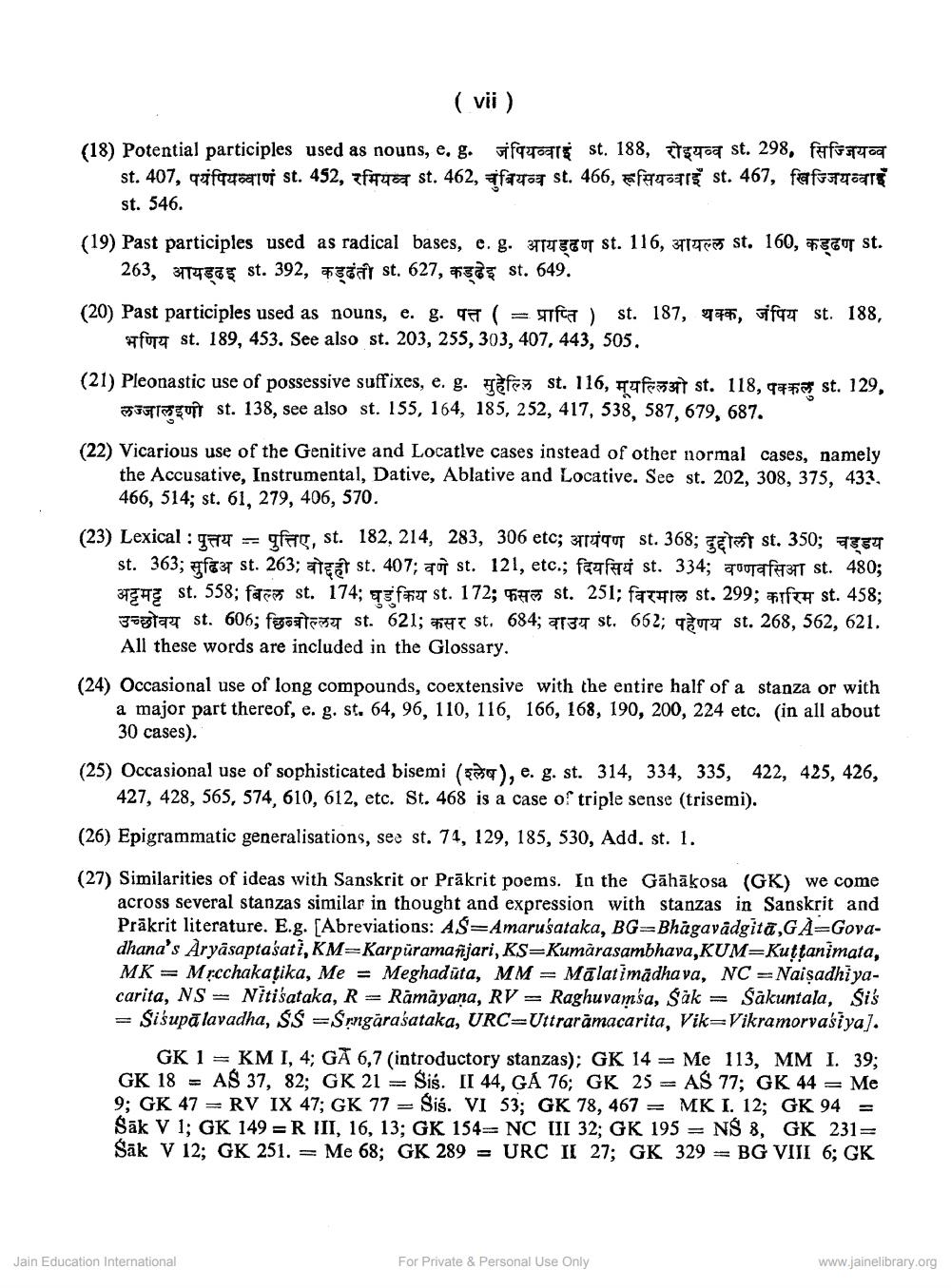________________
(vii)
(18) Potential participles used as nouns, e. g. iqroars st. 188, troq st. 298, fufcituo
st. 407, q7fqualo st. 452, 44 st. 462, fara st. 466, f arz st. 467, fafotiaans
st. 546. (19) Past participles used as radical bases, e. g. TTEET st. 116, T st. 160, Ego st.
263, 34TTF st. 392, xezal st. 627, at st. 649.
fqz
st. 188,
(20) Past participles used as nouns, e. g. TFT ( = stica ) st. 187, 97,
fora st. 189, 453. See also st. 203, 255, 303, 407, 443, 505.
(21) Pleonastic use of possessive suffixes, e. g. ef st. 116, Fuf st. 118, 97** st. 129,
535|guit st. 138, see also st. 155, 164, 185, 252, 417, 538, 587, 679, 687.
(22) Vicarious use of the Genitive and Locatlve cases instead of other normal cases, namely
the Accusative, Instrumental, Dative, Ablative and Locative. See st. 202, 308, 375, 433. 466, 514; st. 61, 279, 406, 570.
(23) Lexical : FTTT = qey, st. 182, 214, 283, 306 etc; TUTTU st. 368; Tot st. 350; FEET
st. 363; efter st. 263; atga st. 407; TT st. 121, etc.; faftu st. 334; qoutaf3T st. 480;
4 st. 558; faca st. 174; Teff st. 172; 27 st. 251; fatis st. 299; #ifta st. 458; 3=øtay st. 606; fant st. 621; *** st. 684; T34 st. 662; TEUTT st. 268, 562, 621.
All these words are included in the Glossary. (24) Occasional use of long compounds, coextensive with the entire half of a stanza or with
a major part thereof, e. g. st. 64, 96, 110, 116, 166, 168, 190, 200, 224 etc. in all about
30 cases). (25) Occasional use of sophisticated bisemi (90), e. g. st. 314, 334, 335, 422, 425, 426,
427, 428, 565, 574, 610, 612, etc. St. 468 is a case o triple sense (trisemi). (26) Epigrammatic generalisations, ses st. 74, 129, 185, 530, Add. st. 1.
(27) Similarities of ideas with Sanskrit or Prākrit poems. In the Gāhākosa (GK) we come
across several stanzas similar in thought and expression with stanzas in Sanskrit and Prākrit literature. E.g. [Abreviations: AŚ=Amaruśataka, BG=Bhagavadgita,GÀ=Govadhana's Aryāsaptašati, KM=Karpüramañjari, KS=Kumarasambhava,KUM=Kuttanimata, MK = Mrcchakaţika, Me = Meghadūta, MM = Malatimadhava, NC =Naişadhi yacarita, NS = Nitišataka, R = Ramayana, RV = Raghuvamsa, Śåk = Sakuntala, Siś = Siśupā lavadha, SS =Śrgāraśataka, URC=Uttraramacarita, Vik=Vikramorvasiya].
GK 1 = KM I, 4; GÀ 6,7 (introductory stanzas); GK 14 = Me 113, MM I. 39; GK 18 = A$ 37, 82; GK 21 = Sis. II 44, GA 76; GK 25 = A$ 77; GK 44 = Me 9; GK 47 = RV IX 47; GK 77 = Siś. VI 53; GK 78, 467 = MK I. 12; GK 94 = Sāk V 1; GK 149 = R III, 16, 13; GK 154= NC III 32; GK 195 = NŚ 8, GK 231= Śāk V 12; GK 251. = Me 68; GK 289 = URC IL 27; GK 329 = BG VIII 6; GK
Jain Education International
For Private & Personal Use Only
www.jainelibrary.org




